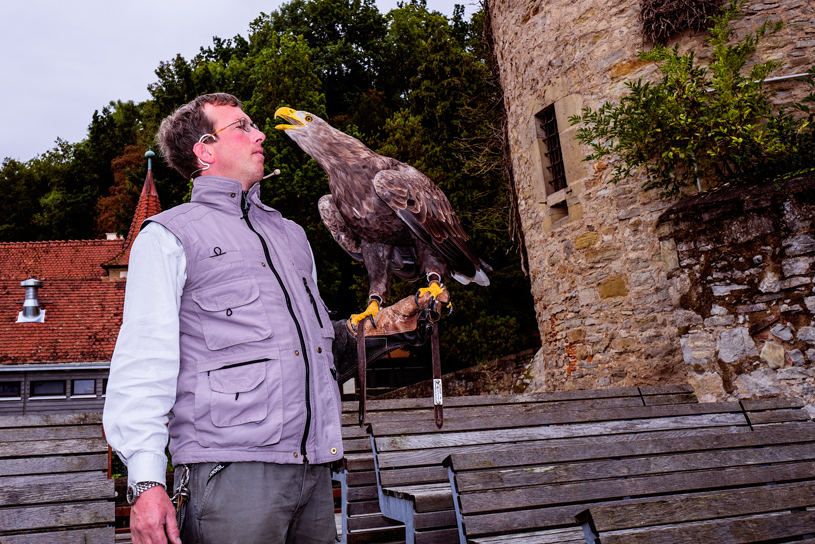Sustainably modern: the barons of Gemmingen-Guttenberg at Guttenberg Castle in the Neckar valley.
The sea eagle spreads its wings and takes off. The spectators hold their breath as the huge animal swoops right over their heads, and for a few split seconds they can feel the stroke of its wings. The raptor now elegantly circles over Guttenberg Castle and after a spectacular dive finally alights on the arm of the falconer. Applause. The spectators are impressed – as always.
Every day from the beginning of March to the end of October and in almost all weather, the “ground crew” of the “Deutsche Greifenwarte” (German Raptor Centre) trains its eagles, vultures and eagle owls and shows their skills in flying demonstrations.
Up here, high above the roofs of the municipality of Haßmersheim, the flying show of the majestic birds of prey is not the only attraction for visitors. The medieval castle is located exposed on a mountain spur between the valleys of the Neckar and the Mühlbach – and stands for a successful transition from tradition to modernity. No enemies have to be warded off here. It rather is about being open-minded and preserving the castle for future generations. “Sustainable development plays a key role. We want to create services that are suited to who we are”, the chatelaine Silke von Gemmingen-Guttenberg explains.
The barons now live in the Staufer castle in the 15th, 16th and 17th generation. In present times, Silke and Bernolph von Gemmingen-Guttenberg have navigated their estate into the future using modern means. The residents of the castle indeed seem quite normal, communicate digitally and gladly report about what it feels like to live as a family of six in a castle which was purchased by one of their ancestors in 1449.
Gabriele Freifrau von Gemmingen-Guttenberg, the mother of the present lord of the castle, realised quite early that the future of the castle dating back to the Staufer era would be shaped by visitors. This is evident by the fact that as early as in 1949 a castle museum was established. Today, a sophisticated pedagogical concept offers an insightful glimpse into castle life in the past. Each room is dedicated to one era and one castle inhabitant of that time – making the exhibition between the massive shield wall and the castle keep a vivid demonstration of what “living in a knight’s castle” was like. That this concept of the museum works is demonstrated by the approximately 30,000 visitors each year.




















